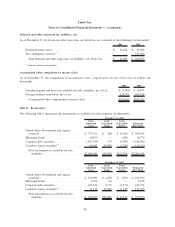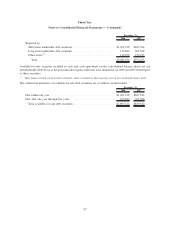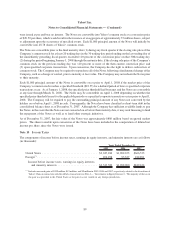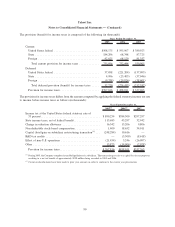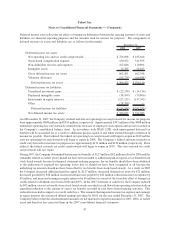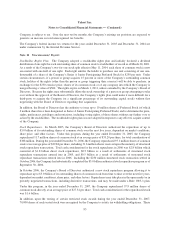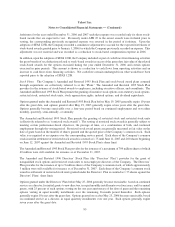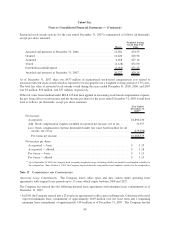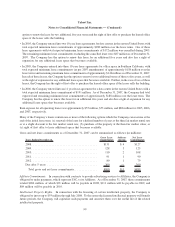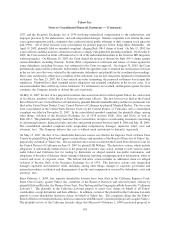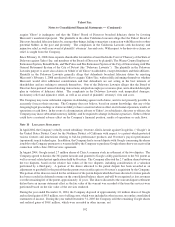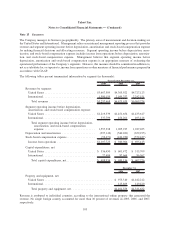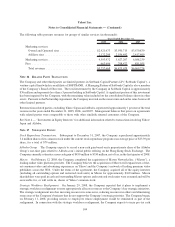Yahoo 2007 Annual Report Download - page 98
Download and view the complete annual report
Please find page 98 of the 2007 Yahoo annual report below. You can navigate through the pages in the report by either clicking on the pages listed below, or by using the keyword search tool below to find specific information within the annual report.
Restricted stock units granted under the Directors’ Plan vest in equal quarterly installments over a one year period
following the date of grant and, once vested, are payable in an equal number of shares of the Company’s common
stock on the earlier of the third anniversary of the grant date or the date the director ceases to be a member of the board.
Non-employee directors are also permitted to elect an award of restricted stock units or a stock option under the
Directors’ Plan in lieu of a cash payment of fees for serving as chairperson of a board committee. Such stock
options or restricted stock unit awards granted in lieu of cash for chairperson fees are fully vested on the grant date.
Employee Stock Purchase Plan. The Company’s 1996 Employee Stock Purchase Plan (the “Purchase Plan”)
allows employees to purchase shares of the Company’s common stock through payroll deductions of up to
15 percent of their annual compensation subject to certain Internal Revenue Code limitations. The price of common
stock purchased under the Purchase Plan is equal to 85 percent of the lower of the fair market value of the common
stock on the commencement date of each 24-month offering period or the specified purchase date. The Purchase
Plan provides for the issuance of a maximum of 45 million shares of common stock of which 23 million shares were
available as of December 31, 2007. For the years ended December 31, 2006 and 2007, the stock-based
compensation expense related to the activity under the Purchase Plan was $55 million and $48 million, respectively.
As of December 31, 2007, there was $66 million of unamortized stock-based compensation cost related to the
Purchase Plan which will be recognized over a weighted average period of 1.26 years.
Executive Retention Compensation Agreement. During 2006, the Compensation Committee of the Company’s
Board of Directors, approved a three year performance and retention compensation arrangement with Terry Semel,
the Company’s then Chief Executive Officer (“CEO”). For each of the years 2006 to 2008, as the CEO, Mr. Semel
was eligible to receive a discretionary annual bonus payable in the form of a fully vested non-qualified stock option
for up to 1 million shares with an exercise price equal to the closing trading price of the Company’s common stock
on the date of the grant.
On June 18, 2007, the executive retention arrangement was terminated due to Mr. Semel’s resignation as the CEO of
the Company. During the second quarter of 2007, $16 million of stock-based compensation expense recorded
through March 31, 2007 under this arrangement was reversed due to the forfeitures of equity awards. No similar
arrangement exists for the current CEO. See Note 17 — “Subsequent Events” for additional information related to
the Company’s change in control severance plans.
Stock option activity under the Company’s Plans and Directors’ Plan is summarized as follows (in thousands,
except years and per share amounts):
Shares
Weighted Average
Exercise Price per
Share
Weighted Average
Remaining
Contractual Life
(in years)
Aggregate
Intrinsic Value
Outstanding at December 31, 2006 .... 189,655 $29.46 5.66 $730,198
Options assumed.................. 6,952 $ 4.36
Options granted .................. 38,264 $26.86
Options exercised
(1)
............... (23,561) $12.28
Options cancelled /forfeited/ expired . . . (30,913) $34.30
Outstanding at December 31, 2007 .... 180,397 $29.36 5.08 $467,655
Vested and expected to vest at
December 31, 2007
(2)
............ 170,924 $29.35 5.02 $459,858
Exercisable at December 31, 2007..... 107,046 $30.20 4.36 $382,539
(1)
The Company’s current practice is to issue new shares to satisfy stock option exercises.
(2)
The expected to vest options are the result of applying the pre-vesting forfeiture rate assumptions to total outstanding options.
96
Yahoo! Inc.
Notes to Consolidated Financial Statements — (Continued)


